NCERT Exemplar Class 10 Science Chapter 3 Metals And Non-Metals are part of NCERT Exemplar Class 10 Science . Here we have given NCERT Exemplar Class 10 Science Chapter 3 Metals And Non-Metals.
NCERT Exemplar Class 10 Science Chapter 3 Metals And Non-Metals
Short Answer Type Questions
1.Iqbal treated a lustrous, divalent element M with sodium hydroxide. He observed the formation of bubbles in reaction mixture. He made the same observations when this element was treated with hydrochloric acid. Suggest how can he identify the produced gas. Write chemical equations for both the reactions.
Answer:
M + 2NaOH —>Na
2
M0
2
+ H
2
(g)
M + 2HCl —> MCl
2
+ H
2
(g)
Bring a burning candle near the gas. If it burns with pop sound, the gas is hydrogen and the element is a metal.
2 During extraction of metals, electolytic refining is used to obtain pure metals.
(a) Which material will be used as anode and cathode for refining of silver metal by this process?
(b) Suggest a suitable electrolyte also.
(c) In this electrolytic cell, where do we get pure silver after passing electric current?
Answer:
(a) Pure silver rod will be used as cathode and impure silver rod will be used as anode.
(b) Ag NO
3
(aq) can be used as electrolyte.
(c) Pure silver will be formed at cathode.
At anode : Ag —> Ag
+
+e
–
At cathode : Ag
+
+e
–
—> Ag
3.Generally, when metals are treated with mineral acids, hydrogen gas is liberated but when metals (except Mn and Mg), treated with HNOs, hydrogen is not liberated. Why?
Answer
.It is because HNO
3
is an oxidising agent and it gets reduced to NO if it is dilute and NO
2
if HNOs is concentrated, it oxidises H
2
to H
2
O.
4.Compound X and aluminium are used to join railway tracks.
(a) Identify the compound X.
(b) Name the reaction.
(c) Write down its reaction.
Answer.

5.What are the constituents of solder alloy? Which property of solder makes it suitable for welding electrical wires?
Answer. Solder is made up of lead and tin. It has low melting point, therefore, it is used for soldering (welding) electrical wires.
6.A metal A, which is used in thermite process, when heated with oxygen gives
an oxide B, which is amphoteric in nature? Identify A and B. Write down the reactions of oxide B with HC1 and NaOH.
Answer: ‘A’ is aluminium.
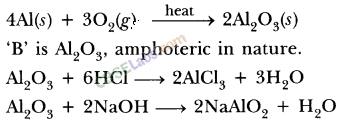
7.What happens when
(a) ZnCOs is heated in the absence of oxygen?
(b) a mixture of Cu
2
O and Cu
2
S is heated?
Answer:

8.A non-metal A is an important constituent of our food and forms two oxides B and C. Oxide B is toxic whereas oxide C causes global warming.
(a) Identify A, B and C.
(b) To which group of periodic table does A belong?
Answer:
(a) A is carbon. It forms two oxides: CO (B) is toxic whereas CO
2
(C) causes
global warming as it absorbs heat radiations from atmosphere.
(b) A belongs to group 14 of periodic table.
9.An element A reacts with water to form a compound B which is used in white washing. The compound B on heating forms an oxide C which on treatment with water gives back B. Identify A, B and C and give the reactions involved.
‘A’ is calcium metal, ‘B’ is calcium hydroxide, ‘C’ is calcium oxide.
Answer:
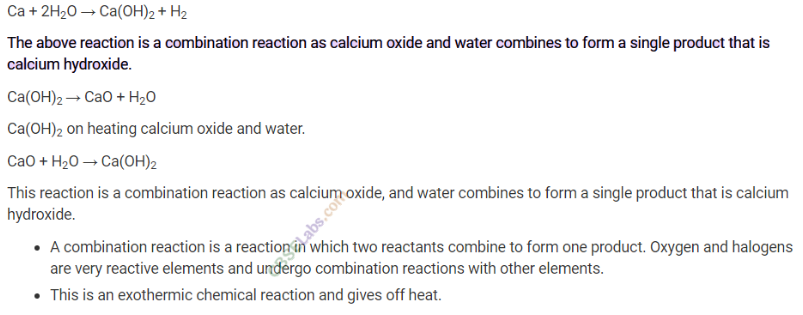
10. A metal M does not liberate hydrogen from acids but reacts reacts with oxygen to give a black colour product. Identify M and black coloured product and also explain the reaction of M with oxygen.
Answer:
M is ‘Cu’. It does not liberate hydrogen with dilute acid as it is less reactive than hydrogen gas.

11. A solution of CuS04 was kept in an iron pot. After few days, the iron pot was found to have a number of holes in it. Explain the reason in terms of reactivity. Write the equation of the reaction involved.
Answer: Iron is more reactive than copper. Therefore, it displaces copper from copper sulphate solution.

12. When a metal ‘X’ is treated with cold water, It gives base salt ‘X’ with molecular formula XOH (Molecular mass = 40) and liberate a gas Z which easily catches fire. Identify X, Y and Z and also write the reaction involved.
Answer.
‘X’ is Na ‘Y’ is NaOH ‘Z’ is H2 gas

13. A non-metal ‘X’ exists in two different forms ‘Y’ and ‘Z\ ‘Y’ is hardest natural substance, whereas ‘Z’ is good conductor of electricity. Identify X, Y and Z.
Answer: ‘X’ is carbon ‘Y’ is diamond ‘Z’ is graphite.
‘Y’ (diamond) is hardest natural substance.
‘Z’ (graphite) is good conductor of electricity.
14. The following reaction takes place when aluminium powder is heated with MnO
2
:
3MnO
2
(s) + 4Al(s)—–> 3Mn(l) + 2Al
2
O
3
(l) + Heat
Molten Molten
(a) Is aluminium getting reduced ?
(b) Is MnO
2
getting oxidised ?
Answer:
(a) No, aluminium is getting oxidised.
(b) No, MnO
2
is getting reduced.
15. A metal that exists as liquid at room temperature is obtained by heating its sulphide in the presence of air. Identify the metal and its ore and give the reaction involved.
Answer: The metal is mercury.
2HgS(s) + 3O
2
(g)—–> 2HgO(s) + 2SO
2
(g)
HgS(s) + 2HgO(s)—–> 3Hg(l) + SO
2
(g)
16. Give the formulae of the stable binary compounds that would be formed by the combination of following pairs of elements :
(a) Mg and N
2
(b) Li and 02
(c) A1 and Cl
2
(d) K and O
2
Answer:
(a) 3Mg + N
2
—–> Mg
3
N
2
(b) 4Li + O
2
—–> 2Li
2
0
(c) 2Al + 3Cl
2
—–> 2AlCl
3
(d) 4K + O
2
—–> 2K
2
O
17.Give two examples each of the metals that are good conductors and poor conductors of heat respectively.
Answer: Good conductors of heat are copper and silver. Poor conductors of heat are lead and mercury.
18. Name-one metal and one non-metal that exist in liquid state at room temperature. Also name two metals having melting point less than 310 K (37 °C).
Answer: Metal in liquid state is mercury, non-metal in liquid state is bromine.
Gallium (Ga) and Cesium (Cs) have melting point below 310 K.
19. An alkali metal A gives a compound B (molecular mass = 40) on reacting with water. The compound B gives a soluble compound C on treatment with aluminium oxide. Identify A, B and C and give the reaction involved.
Answer:

‘C’ is sodium meta aluminate, soluble in water.
20. Give the reaction involved during extraction of zinc from its ore by
(a) roasting of zinc ore.
(b) calcination of zinc ore.
Answer:

21. An element forms an oxide, A
2
Os which is acidic in nature. Identify A as a metal or non-metal.
Answer: A is non-metal as non-metallic oxides are acidic in nature.
Long Answer Type Questions
22. A non-metal A which is the largest constituent of air, when heated with H2 in 1 : 3 ratio in the presence of catalyst (Fe) gives a gas B. On heating with O
2
, it gives an oxide C. If this oxide is passed into water in the presence of air, it gives an acid D which acts as a strong oxidising agent.
(a) Identify A, B, C and D.
(b) To which group of periodic table does this non-metal belong?
Answer:
(a) N
2
is largest constituent of air, when heated with H
2
in the ratio of 1 : 3 .
in the presence of catalyst (Fe) gives a gas NH
3
(B).

Nitrogen reacts with oxygen on heating to form nitrogen monoxide ‘C’, which gets oxidised in the presence of O
2
to nitrogen dioxide. Nitrogen dioxide dissolves in water in the presence of oxygen to form nitric acid which is an oxidising agent.
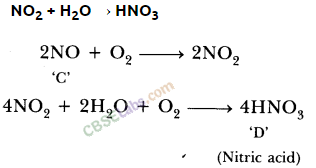
‘A’ is N
2
, ‘B’ is NH
3
, ‘C’ is NO and ‘D’ is HNO
3
.
(b) Group 15
23. Explain the following:
(a) Reactivity of A1 decreases if it is dipped in HNO
3
.
(b) Carbon cannot reduce the oxides of Na or Mg.
(c) NaCl is not a conductor of electricity in solid state whereas it does conduct electricity in aqueous solution as well as in molten state.
(d) Iron articles are galvanised.
(e) Metals like Na, K, Ca and Mg are never found in their free state in nature.
Answer:
(a) It is due to the formation of oxide layer on its surface.
(b) It is because Na or Mg are strong reducing agents, therefore, carbon cannot reduce their oxides.
(c) NaCl does not conduct electricity in solid state as it does not have free ions to move in solid state but in aqueous solution and in molten states ions are free to move.
(d) Iron articles are galvanised to protect them from rusting.
(e) It is because these metals are highly reactive and occur in the form of their compounds.
24.An element A burns with golden flame in air. It reacts with another element B, atomic number 17 to give a product C. An aqueous solution of product C on electrolysis gives a compound D and liberates hydrogen. Identify A, B, C and D. Also write down the equations for the reactions involved, HOTS;
Answer: A is sodium as it burns with golden flame in air.
‘B’ (17) has electronic configuration 2, 8, 7 so ‘B’ is chlorine
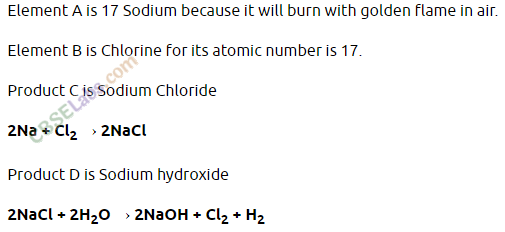
A is Na, ‘B’ is Cl
2
, ‘C’ is NaCl and ‘D’ is NaOH.
25.Give the steps involved in the extraction of metals of low and medium reactivity from their respective sulphide ores.
Answer:
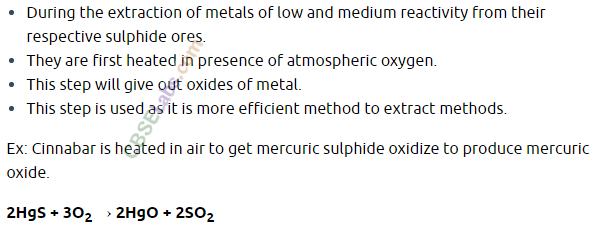
Metal sulphide like HgS reacts with 02 to form mercuric oxide and sulphur dioxide. Mercuric oxide is unstable changes to Hg(l) which can be refined by distillation.
2HgS 4- 3O
2
—–> 2HgO + 2SO
2
HgS + 2HgO —–> 3Hg + SO
2
Sulphide ore like Zn, on roasting (in presence of O
2
) gives metal oxide which on reduction with metal sulphide (ZnS) or suitable reducing agent gives metal which is refined by electrolyte refining.
2ZnS + 3O
2
—–> 2ZnO + 2SO
2
2ZnO + ZnS —–> 3Zn + SO
2
Alternative method of reduction :
ZnO + C —–> Zn + CO
Pure zinc is obtained by electrolytic refining.
26.Of the three metals X, Y and Z, X reacts with cold water, Y with hot water and Z with steam only. Identify X, Y and Z and also arrange them in order of increasing reactivity.
Answer: X’ is sodium or potassium metal.
2Na(s) + 2HsO(l) —–> 2NaOH(aq) + H
2
(g)
‘X’ ‘cold’
Or
2K(s) + 2H
2
O(l) —–> 2KOH(aq) + H
2
(g)
‘X’ ‘cold’

Fe < Mg < Na < K is an increasing order of reactivity.
27.Two ores A and B were taken. On heating, ore A gives CO
2
whereas, ore B gives SO
2
. What steps will you take to convert them into metals ?
Answer:Since ore ‘A’ gives CO
2
and ore ‘B’ gives SO
2
. Therefore, A is metal carbonate ore and ‘B’ is metal sulphide ore.
Metal carbonate on heating gives ‘MO’.

‘MO’, on reduction with coke gives metal and carbon monoxide.
![]()
Metal ‘M’ is obtained which can be purified by electrolytic refining.
Metal sulphide is heated in presence of oxygen to form metal oxide and S02.

Metal sulphide reacts with metal oxide to form impure metal and S02.
![]()
MO can also be reduced with carbon to form metal. The metal ‘M’ from ore ‘B’ is obtained.
![]()
28.Impure metal is purified by electrolytic refining
(i) Given below are steps for extraction of copper from its ore. Write the reaction involved.
(a) Roasting of copper (I) sulphide
(b) Reduction of copper (I) oxide with copper (I) sulphide
(c) Electrolytic refining
(ii) Draw the neat and labelled diagram for electrolytic refining of copper.
Answer:
(i)
(a) 2CU
2
S(S) + 3O
2
(g) ——–> 2Cu
2
O(s) + 2SO
2
(g)
(b) 2CU
2
O(S) + Cu
2
S(s) ——–> 6CU(s) + SO
2
(g)
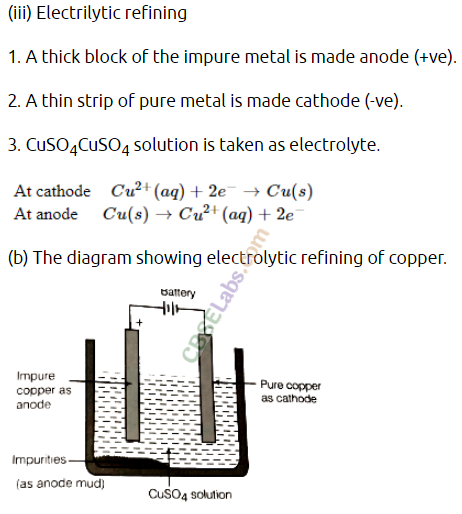
NCERT Exemplar Class 10 Science Solutions
- Chapter 1 Chemical Reactions and Equations
- Chapter 2 Acids Bases and Salts
- Chapter 3 Metals and Non-metals
- Chapter 4 Carbon and its Compounds
- Chapter 5 Periodic Classification of Elements
- Chapter 6 Life Processes
- Chapter 7 Control and Coordination
- Chapter 8 How do Organisms Reproduce
- Chapter 9 Heredity and Evolution
- Chapter 10 Light Reflection and Refraction
- Chapter 11 Human Eye and Colourful World
- Chapter 12 Electricity
- Chapter 13 Magnetic Effects of Electric Current
- Chapter 14 Sources of Energy
- Chapter 15 Our Environment
- Chapter 16 Management of Natural Resources